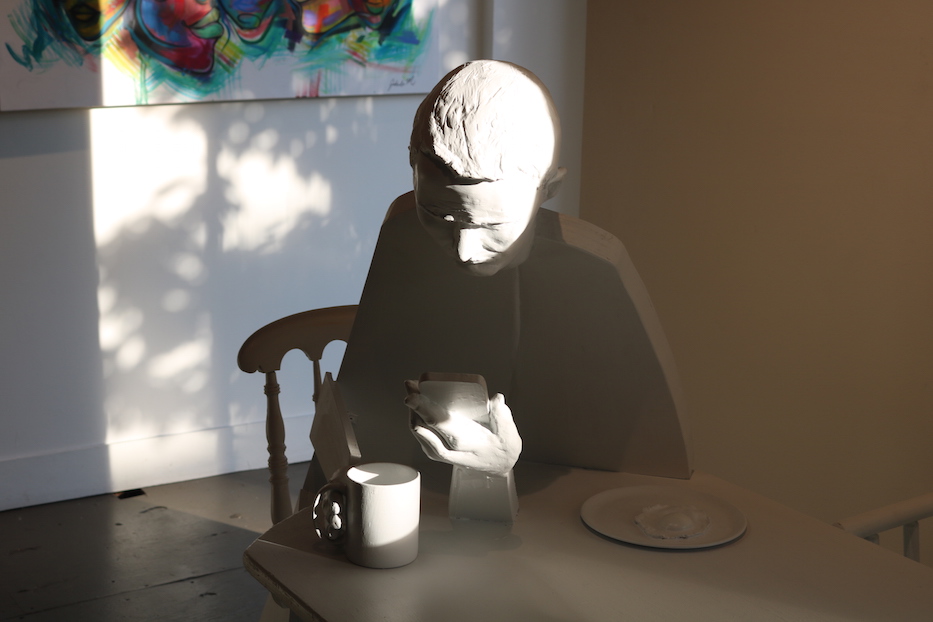
Kehler Liddell Gallery | Painting | Arts & Culture | Visual Arts | Westville | Sculpture
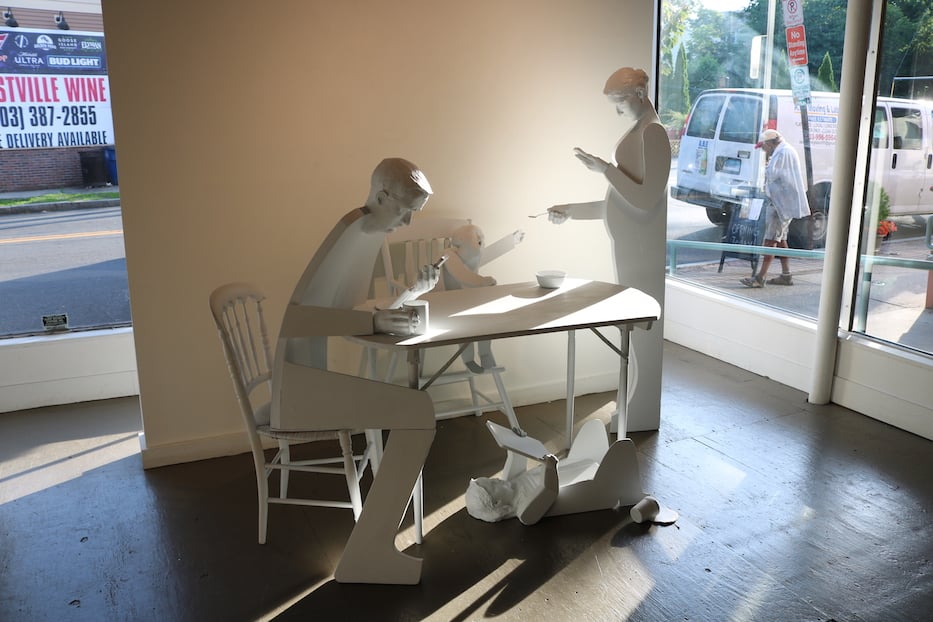
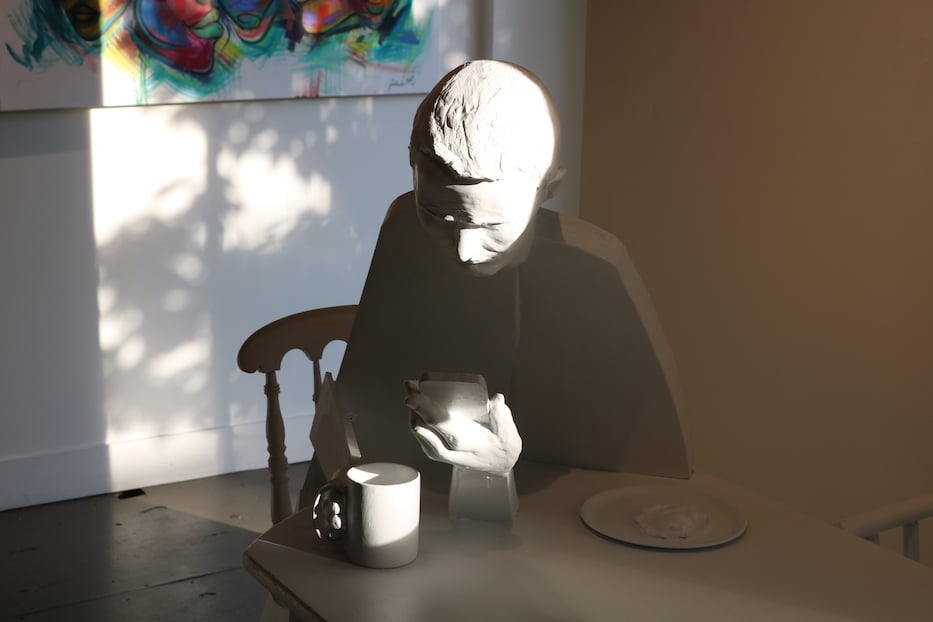
Susan Clinard's Missing The Mark. Amelia Dilworth Photos.
It's dinner time on Thursday night and the baby just wants to eat. He’s leaning over the side of the high chair, reaching for the food, open-mouthed like a baby bird— but his mother is holding the spoon just slightly out of reach.
She is frozen, focused on her cellphone, unconcerned with her hungry child. She’s going through the motions of feeding him, reaching out to him—but she’s missing the mark. Her son will not find nourishment in this distracted world.
Susan Clinard’s sculpture Missing The Mark is one of 70 works in Lost/Found, the sixth annual juried show at Kehler Liddell Gallery (KLG) in New Haven’s Westville neighborhood. The show, which features the work of 65 artists, will be on display at 873 Whalley Ave. through July 31st. Hours and more information are available at the gallery's website.
It represents the work of 20 KLG members and 45 non-member artists chosen from over 200 submissions. Artists work in media ranging from watercolor to sculpture, and hail from New Haven as well as across the region. Over 100 people attended an opening reception last Thursday.
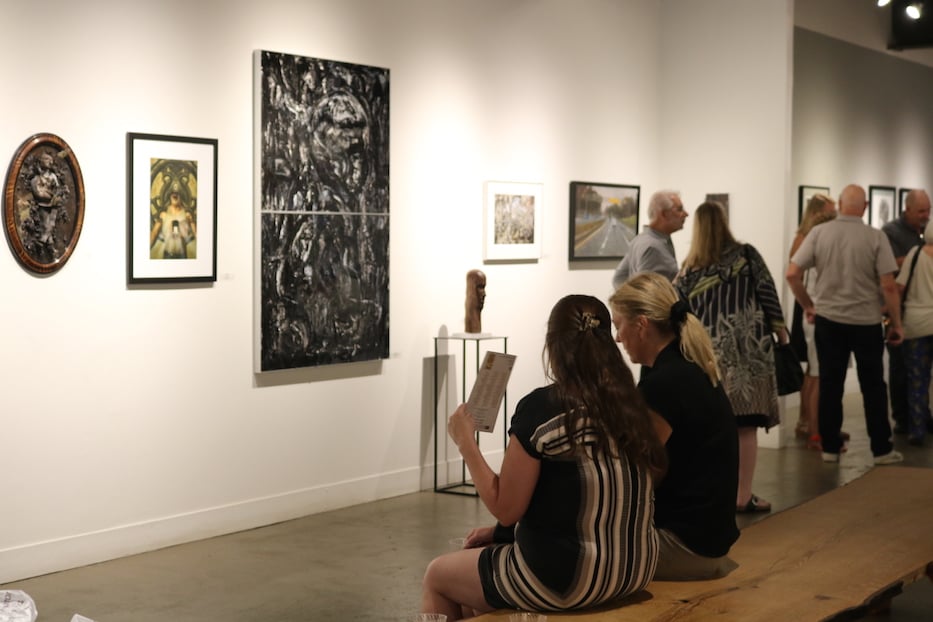
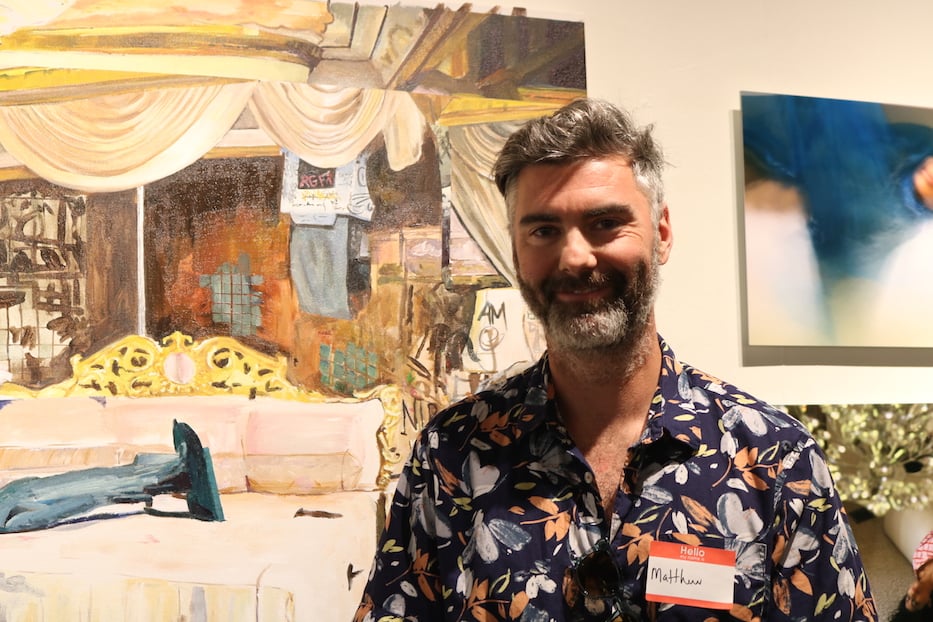
Matthew Robinson, a high school teacher from New York, received a cash prize for his Mar A Lago. Amelia Dilworth Photos.
At the opening, KLG Assistant Director Muffy Pendergast announced a slate of winning artists, including New Haveners Susan Clinard and Terrence Lavin and New Yorker Matthew Robinson. Mary Janacek, Earl Grenville-Killeen, and Basia Tov received gift certificates from Merwin’s Art Shop, Framed, and the Frame Shop in Westville.
Robinson, a high school teacher from New York, received a cash prize for his Mar A Lago. The painting shows a creamy, oversized, luxury-resort bed with a gilded headboard and swooping curtains, glowing with light from chandeliers. But the collage-like painting compiles this glamorous, opulent setting with a dingy tile wall covered in graffiti. The gridded window panes of industrial-era factories are eating through the walls behind the bed. A patina-green statue, rigid and weathered, collides with the decadent mattress. Robinson presents a shattered vision of a gritty urban reality flooding into decaying luxury.
Beneath the disembodied feet of a woman’s crossed legs, a pair of bronze feet stand on a pedestal—like a memorial to a founding father gone awry. All that remains is the foundation his buckled shoes stand on.
Robinson produced a whole series of paintings while isolating due to the pandemic in 2020 and 2021. He had the time to reflect on politics, and found that "it wasn’t really necessarily a choice,” he said. “It was just kind of thrown at us. So a lot of the pieces that came out of those years were very similar to this: politically leaning, without a linear narrative telling you what to think. Just a reflection of my own feelings.”
Denise Vosburgh, a New Haven-based painter and sculptor, noted that politics and art are often a difficult mix— but Mar A Lago was “well-executed and noteworthy.”
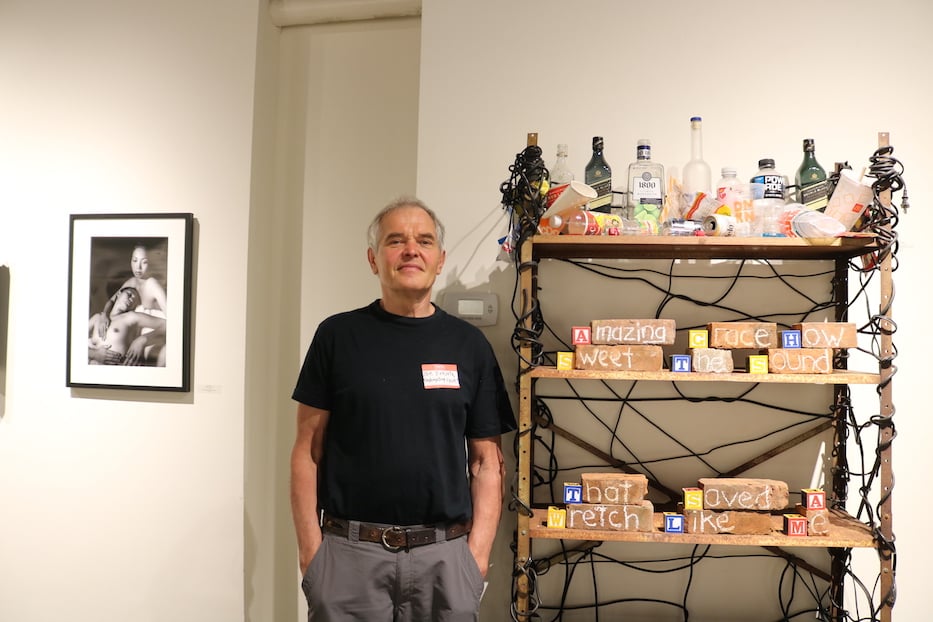
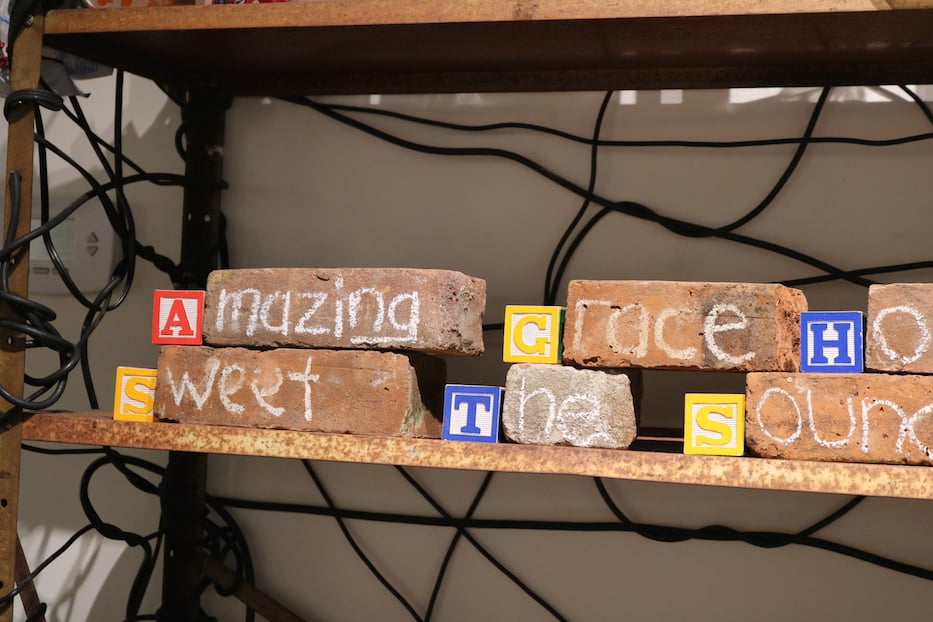
Joe Fekieta’s Redemption Cycle. Amelia Dilworth Photos.
Across the gallery, Joe Fekieta’s sculpture Redemption Cycle covers a bookshelf in the chaos of highway litter. It is tied up in electrical wires, but falling apart in waste. Empty bottles of sports drinks and alcohol, fast food trash, wrinkled bags of chips, cigarette butts and crushed cans of beer all spill over the top and bottom shelves.
On the middle shelves, bricks and building blocks spell out the lyrics to Amazing Grace, a traditional hymn about redemption.
A lifelong New Havener, Fekieta said that all children are born into “amazing grace,” but “addictions infiltrate our adult life and remove that state of amazing grace.” He identified three addictions that he represents in his work: “alcohol, cigarettes, and junk food.”
However, the title of the sculpture refers to the traditional interpretation of “Amazing Grace” as forgiveness and freedom rather than lost innocence. The lyric “I once was lost, but now I’m found” suggests losing oneself and finding grace, not losing innocence and finding addictions.
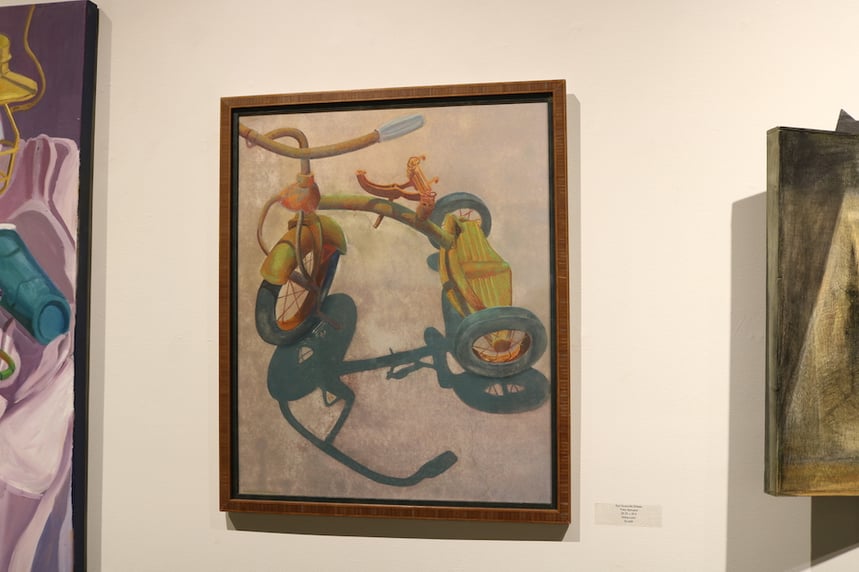
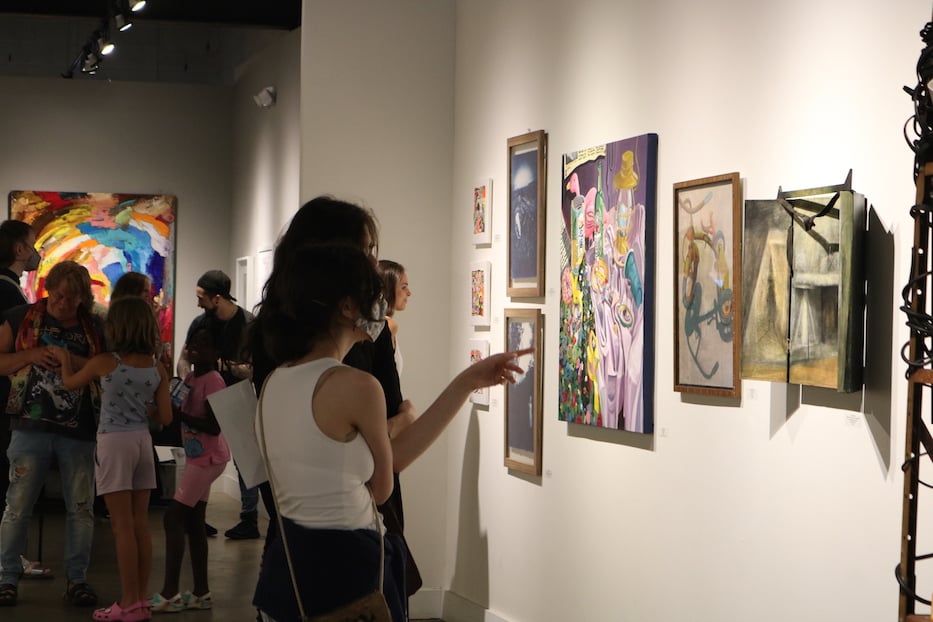
Artist Earl Grenville-Kileen's painting Trike Remains. Amelia Dilworth Photos.
Artist Earl Grenville-Kileen's Trike Remains positions the viewer above a child’s tricycle, looking down at the muted colors rendered in watercolor. One handlebar is twisted out of view, not pictured in an unfinished memory.
In an accompanying statement, Grenville-Kileen writes that the painting “is also a depiction of myself as a time-worn relic of what I once was.” As a child, he was too poor to have a tricycle of his own. When his years of nursery school were over, he lost access “not only to my one friend but to the trike I had so treasured at school.” And 70 years later, Grenville-Killen has lost the ability to ride a tricycle or bicycle.
The tricycle’s shadow covers almost as much of the canvas as the tricycle itself. In Trike Remains the physical object, like a tricycle, can be easily found. But that presence casts the quiet, painful shadow of a deeper, unresolved loss.
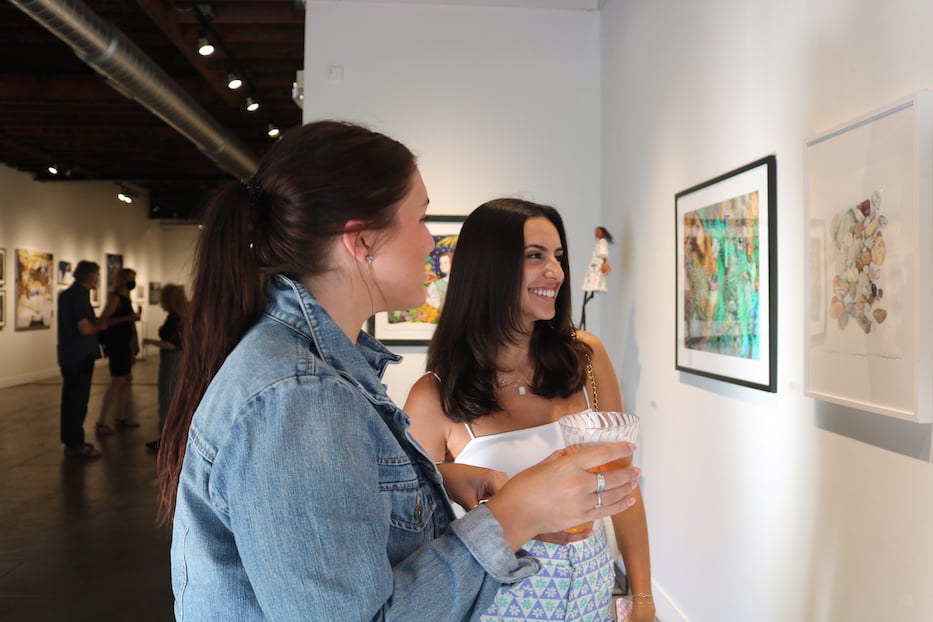
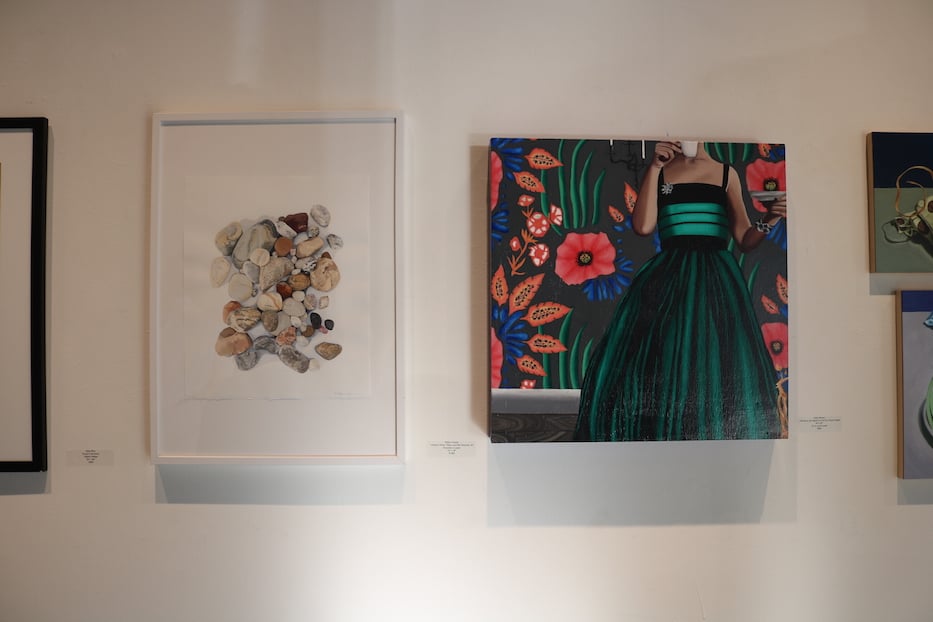
Alicia Afonso’s I Will Never Set Myself On Fire For Anyone Again is pictured in the bottom photo, at the right. Amelia Dilworth Photos.
In Alicia Afonso’s I Will Never Set Myself On Fire For Anyone Again, a woman sips from a teacup, standing in front of a vibrant floral wall. Her full skirt and dainty manners suggest an ambiguous historical setting, but the bold colors of Afonso’s oil painting also ground it in modern day. In her artist statement, Afonso explains that the woman’s head isn’t included in the painting, making her a “universal symbol” of the “sacrifice women often make for men.”
But if the woman’s head were included, she would be staring directly at the viewer with the confidence that Afonso herself found after losing herself in the fire of toxic relationships. “I had to lose myself to find myself again,” she writes, “and I wouldn’t change the lessons I’ve learned.”
Despite the themes of nostalgia throughout the show and the shared sense that something precious has been lost in the past, many of the artists also portray the resiliency and growth they found. The opening event itself was celebratory, as community members admired the art that comes from even difficult times.
Many of the works in Lost/Found ask whether the modern world has lost more than it has found. Nowhere is this more clear than in Missing The Mark.
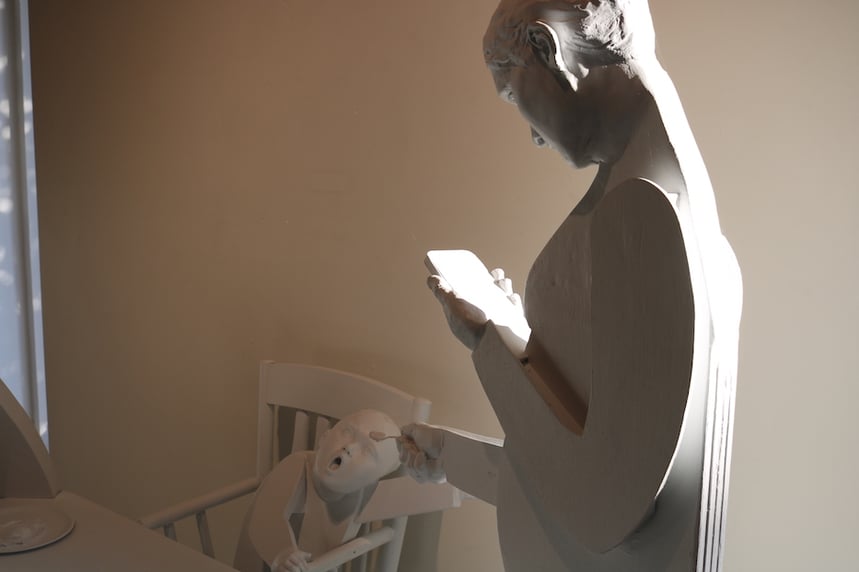
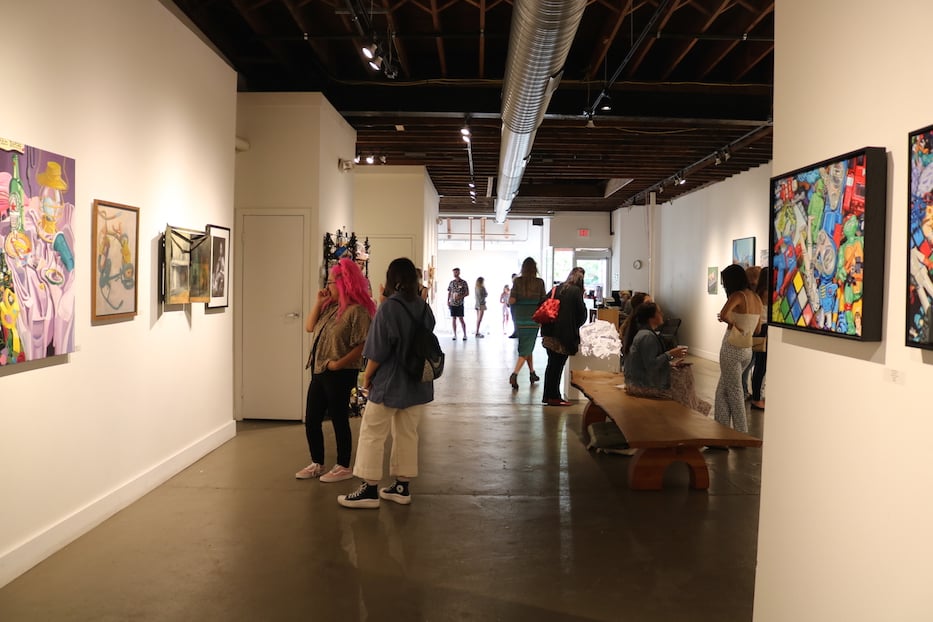
Top: Detail on Susan Clinard's Missing The Mark. Bottom: The gallery on opening night. Amelia Dilworth Photos.
The mother scrolls through her phone, missing her child’s mouth. Her husband is equally oblivious, bent over his phone even as the afternoon sunlight passes through the trees and dances across his face. Their daughter lays underneath the table, watching videos on her tablet, her spilled drink lying in its own puddle besides her.
Despite the chaos and urgency of spilled drinks and hungry babies, the family remains motionless, blank, focused on their devices. How long have they been frozen? What will the world look like when they finally look up from their phones?
Missing The Mark is life-size, forcing viewers to step into this distracted family. The work is so haunting because viewers find themselves in an unsettlingly familiar reality.
But in the gallery on a recent weeknight, families and friends still laughed together and gathered to look at art. People still chatted with neighbors and met new people and thought about life and loss and art. Despite all the suffering and nostalgia that these artists evoke, there was still joy to be found in art itself.
Not all was lost.
Kehler Liddell Gallery is located at 873 Whalley Ave. in the city’s Westville neighborhood. For upcoming events at the gallery, visit KLG’s calendar here.

